If you want to add something a little different to your fish tank, you might want to consider aquarium crabs.
You might think that you only find crabs in the ocean, but did you know that there are many types of freshwater aquarium crabs, most of which are easy to care for and can live for up to four years? Crabs can also make a useful addition to a fish tank cleaning crew, scavenging on any leftover food and even eating some species of algae.
So, to learn about 11 types of freshwater aquarium crabs and how to care for them, keep reading!
11 Types Of Freshwater Aquarium Crabs
Now that you know how to look after freshwater aquarium crabs let’s take a look at 11 species that make a great choice for your tank.
1. Freshwater Fiddler Crab
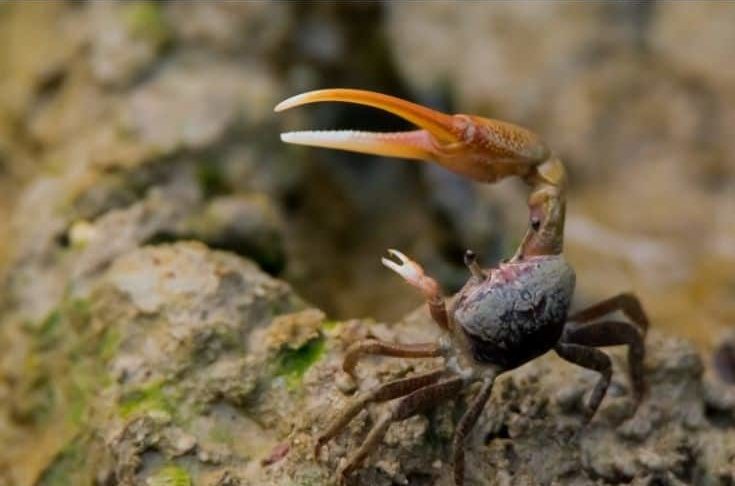
Family: Ocypodidae
Scientific Name: Uca
Other Names/Common Name: Calling crab, Mini crab
Care Level: Easy
Natural Habitat: Indo-Pacific, Eastern Pacific, Western Atlantic regions, mangroves of West Africa, beaches, salt marshes
Aquarium Conditions: 74° to 84° F, KH 12 to 30, pH 8.0 to 8.2
As you might guess from their natural habitat, Fiddler crabs are actually brackish water species rather than true freshwater crabs. Why the confusion? Well, there are over 100 different species of Fiddler crabs.
Fiddlers are easy to spot, as males have one claw that is much bigger than the other. These crabs are semi-aquatic that need to be able to get out of the water when they want to.
Include lots of rocks, driftwood, and the like in the tank for the crabs to climb over and a sandy substrate that the creatures can burrow into.
2. Freshwater Pompom Crab
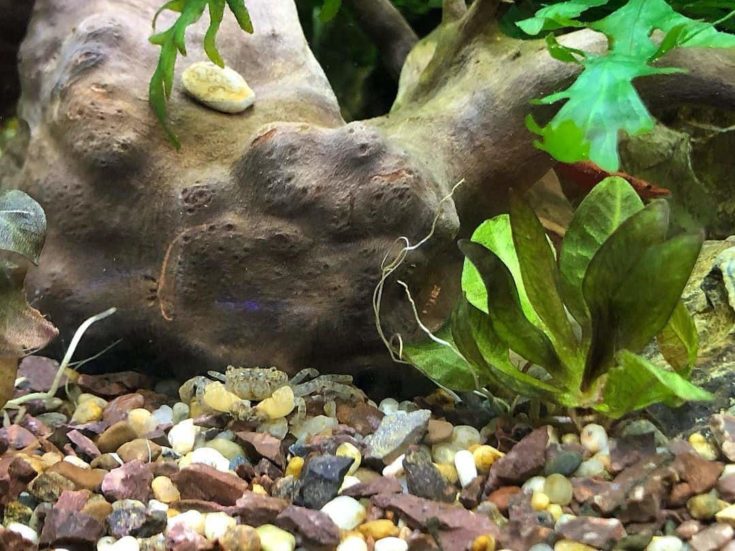
Family: Xanthidae
Scientific Name: Lybia edmondsoni
Other Names/Common Name: Boxer Crab
Care Level: Easy
Natural Habitat: The species is endemic to Hawaii
Aquarium Conditions: 72° to 78° F, dKH 8 to 120, pH 8.1 to 8.4
Pompom crabs are very easy to care for, as long as you keep them at the correct water temperature. These are peaceful creatures that won’t hassle your fish or their other tank mates. In fact, despite their common name, Boxer crabs are far less aggressive than many other species of freshwater crabs.
Pompom crabs are completely aquatic, so they can do fine in fish tanks with fish and other non-aggressive aquatic creatures. Two species go by the same name, one being a marine species, so be careful not to get the two confused when buying your crabs.
3. Vampire Crab
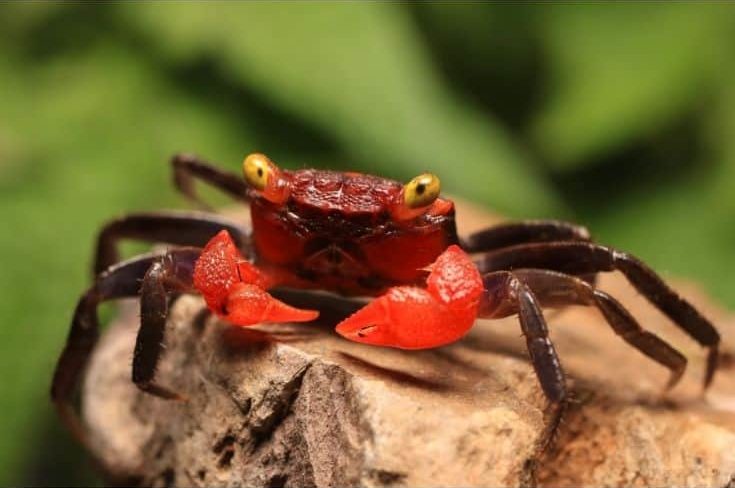
Family: Sesarmidae
Scientific Name: Geosesarma aurantium
Other Names/Common Name: Devil crabs, Carnival crabs, red Devil crabs, carnival crabs
Care Level: Easy to Intermediate
Natural Habitat: India, Southeast Asia, Hawaii, Solomon Islands, Java, Riau, or Krakatau Islands
Aquarium Conditions: 75° to 82° F, dKH 4 to 16, pH 7.5 to 8.5
Vampire crabs are so-named for their bright red and black coloration, not because of their eating habits!
These crabs are semi-aquatic, so you need to provide them with plenty of objects to climb on and rest on. Ideally, the tank needs a split of 50% water and 50% land for these crabs to be happy.
A sandy substrate is best for a Vampire crab tank, and you should include plenty of dense live planting such as Java moss. Since these crabs are quite small, a 10 to 20-gallon tank is fine for a population of up to six crabs. Large snails and shrimp make good tank mates for the Vampire crab.
4. Thai Devil Crabs
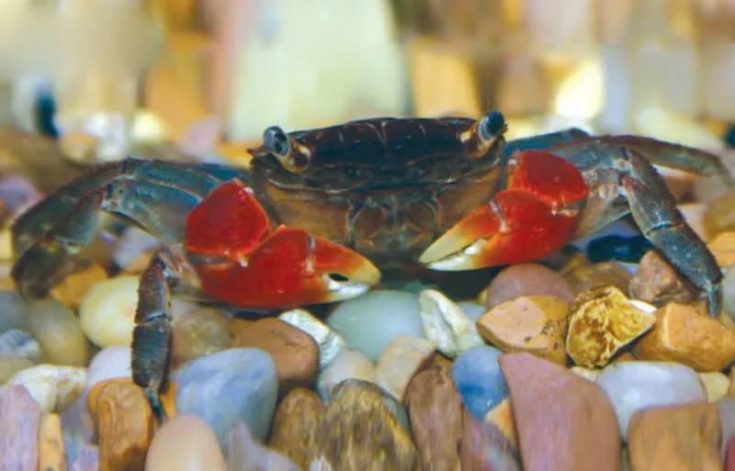
Family: Sesarmidae
Scientific Name: Clariosoma Camifax
Other Names/Common Name: Black Devil crab, Rainbow crab, Soapdish crab, Purple Thai Devil crab
Care Level: Easy
Natural Habitat: Southeast Asian rivers and forests
Aquarium Conditions: 72° to 82° F
The Thai Devil crab is an active but peaceful little crab that comes in various colors, including a gorgeous, bright purple.
You need to provide these crabs with plenty of space since these are lively little guys who love to explore and climb. Also, Thai Devil crabs are not fully aquatic, so they need plenty of dry land to climb up onto, lush planting to shelter in, and sand for digging and burrowing.
5. Panther Crab
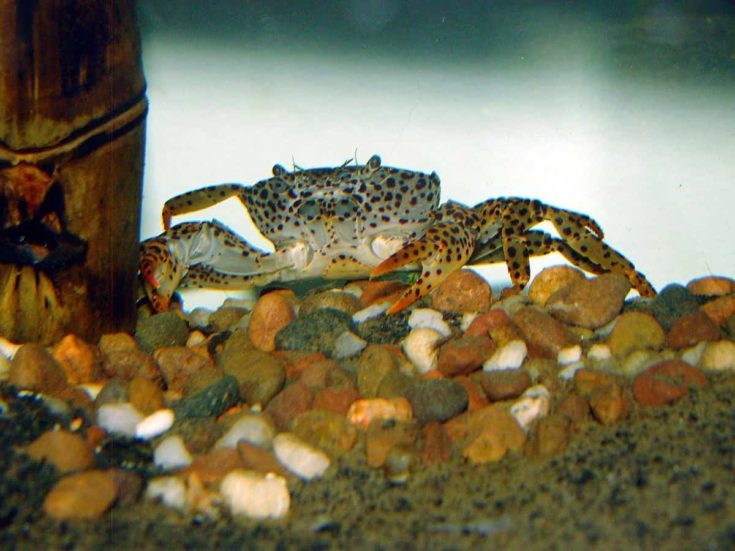
Family: Gecarcinucidae
Scientific Name: Parathelphusa pantherina
Other Names/Common Name: Leopard crab
Care Level: Easy
Natural Habitat: Lake Matano, Indonesia, Sulawesi
Aquarium Conditions: 59° to 86° F, pH 6.0 to 8.4, dKH 5 to 8, dGH 4 to 6
Panther crabs are popular crabs that do well when kept with certain fish species that are quick enough to keep out of the crabs’ way.
These crabs are primarily aquatic, although they do appreciate some dry land to climb onto sometimes. You can keep a small colony of around five Panther crabs in a 15-gallon aquarium.
6. Gold Claw Crab
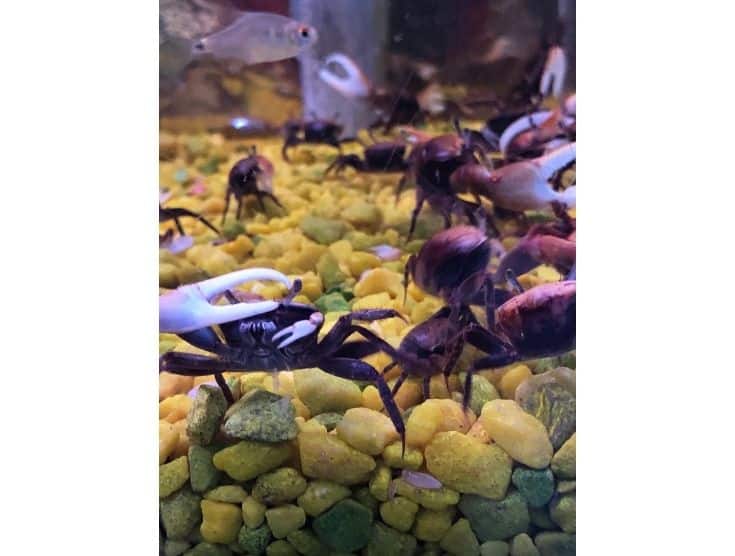
Family: Ocypodidae
Scientific Name: Uca
Other Names/Common Name: Yellow Claw crab
Care Level: Easy
Natural Habitat: Indo-Pacific, Eastern Pacific, Western Atlantic regions, mangroves of West Africa, beaches, salt marshes
Aquarium Conditions: 74° to 84° F, pH 8.0 to 8.2, dKH 12 to 30
The Gold Claw crab is a species of Fiddler crab. These attractive crabs are easy to identify since the males have a large yellow claw.
Unfortunately, Gold Claw crabs tend to destroy live plants. They’re also very efficient escape artists that will make a break for freedom if your aquarium lid isn’t securely fitted.
These crabs like to scavenge across the tank bottom, and they are also burrowers and diggers, so you need to use a sandy substrate for their habitat.
7. Matano Crab
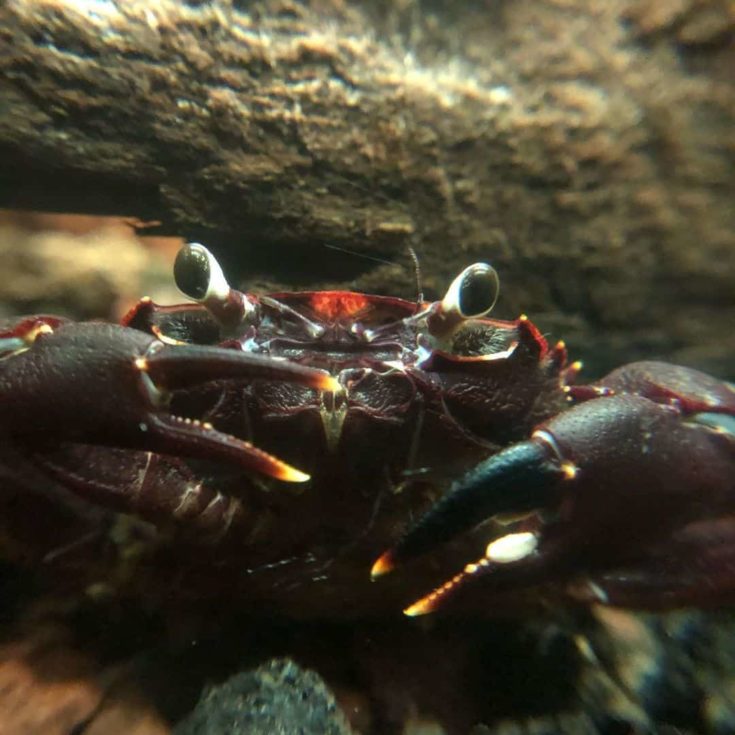
Family: Gecarcinucindae
Scientific Name: Parathelphusa ferruginea
Other Names/Common Name: Yellow Leg Towuti crab
Care Level: Easy
Natural Habitat: Lake Matano, Sulawesi lake system of Indonesia
Aquarium Conditions: 79° to 85° F, pH 7.2 to 8.5, dKH 5 to 8
Matano crabs are sociable, colonizing crabs that do best when kept in groups of five or more. As these are small creatures, a 15-gallon tank is fine for them.
Although these crabs are generally peaceful, I recommend that you keep them with fast-moving fish species. These little crabs are aquatic, although they do appreciate some terrestrial areas to climb up onto.
8. Freshwater Hermit Crab
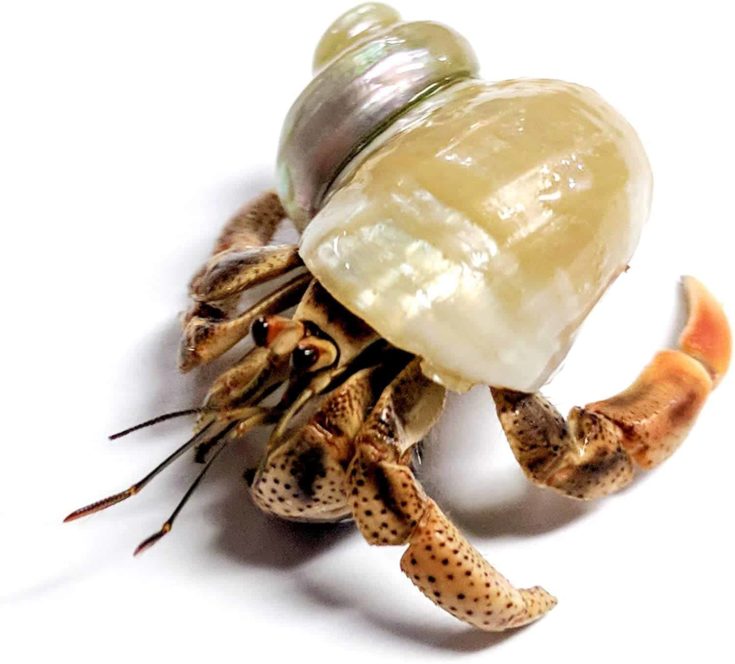
Family: Paguroidea
Scientific Name: Coenobita
Other Names/Common Name: Yellow Leg Towuti crab
Care Level: Easy
Natural Habitat: Indo-Pacific region, West Africa, Pacific Coast
Aquarium Conditions: 79° to 85° F, pH 7.2 to 8.5, dKH 5 to 8
Freshwater Hermit crabs are terrestrial crabs. That means they need to live on land rather than in water.
These little crabs are pretty hardy characters that enjoy a relatively long lifespan and are easy to care for. Hermit crabs are sociable and do best when kept in groups.
The ideal Hermit crab enclosure is mostly deep sand that they can burrow into with a few bowls of water positioned throughout the tank. There should be enough water that the crabs can be fully submerged but not so deep that they can’t get out.
9. Red-Clawed Crab
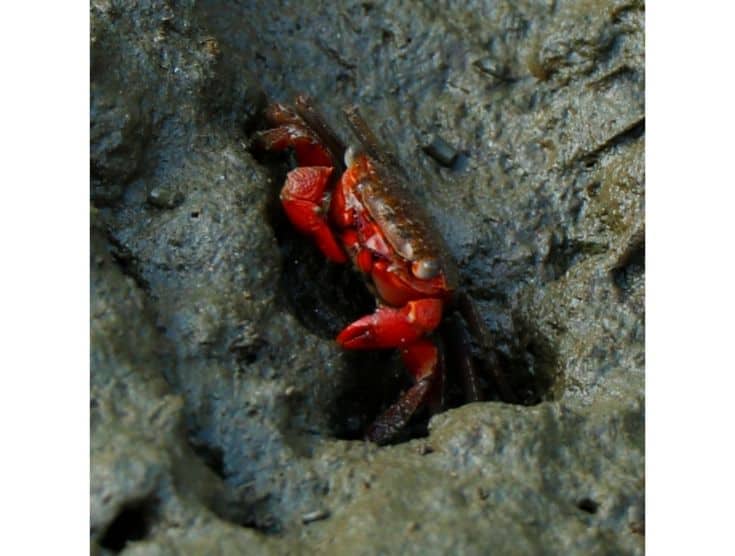
Family: Sesarmidae
Scientific Name: Perisesarma bidens
Other Names/Common Name: Red Claw crab
Care Level: Easy
Natural Habitat: Indo-Pacific coastal regions
Aquarium Conditions: 75° to 81° F, pH 7.5 to 8.5, dKH 10 to 25
Red-Clawed crabs are semi-aquatic creatures that need to be housed in a paludarium or similar setup with a terrestrial area where they can climb up out of the water.
These crabs are expert climbers, and you need a tank with a tightly fitting lid to prevent them from escaping. Also, you’ll need to plug any gaps or holes that the crabs could view as an escape route.
10. Rainbow Land Crab
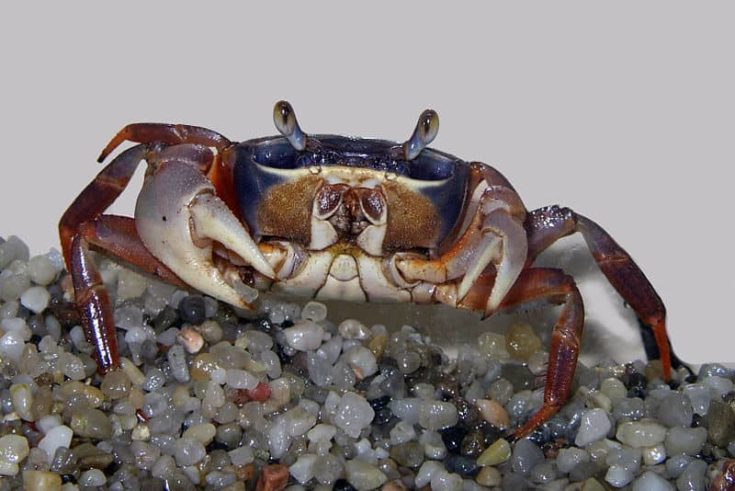
Family: Gecarcinidae
Scientific Name: Cardisoma armatum
Other Names/Common Name: Nigerian Moon Crab, African Rainbow Crab, Patriot Crab
Care Level: Easy/Medium
Natural Habitat: Coastal areas of West Africa
Aquarium Conditions: Brackish, 75° to 85° F
Rainbow crabs are semi-aquatic crabs that need to be housed in a paludarium with plenty of access to land.
These are pretty feisty guys that will attack other crabs, even of their own species, often fighting to the death. So, you can only have one of these brightly colored little crabs in your setup.
Unfortunately, Rainbow Land crabs are destroyers of plants if you don’t supplement their diet with plenty of veggies. These are burrowing crabs that need a deep, sandy substrate where they can create daytime hideouts, emerging at night to feed.
11. Thai Micro Crab
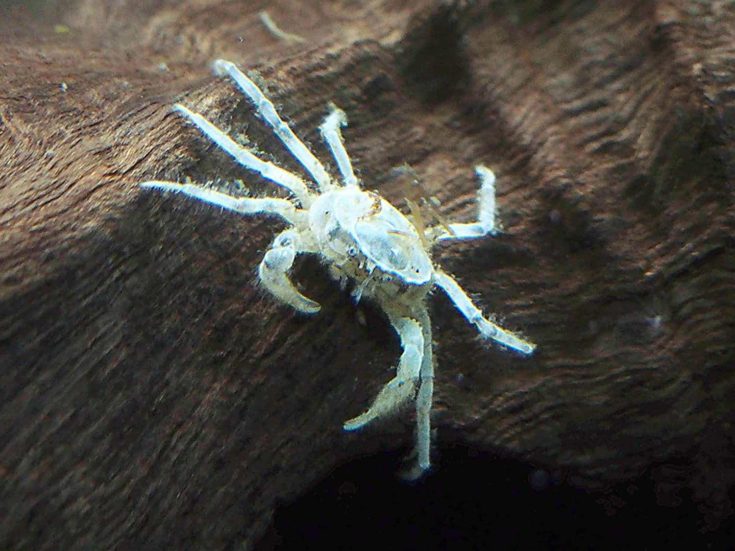
Family: Hymenosomatidae
Scientific Name: Limnopilos naiyanetri
Other Names/Common Name: False Spider crabs
Care Level: Medium
Natural Habitat: Thailand
Aquarium Conditions: 72° to 82° F
Thai Micro Spider crabs are not often seen in the aquarium hobby, largely as they only live in only the Tha Chin River in Thailand. Here, the crabs live hidden among the roots of floating Water Hyacinth plants.
These tiny crabs are exclusively aquatic, and their peaceful, shy nature and tiny size make them good candidates for inclusion in a community setup containing non-aggressive fish species. Keep these beautiful, unusual crabs in groups of five or more.
Helpful Tips For Owning A Freshwater Aquarium Crab
Before we get into the types of crabs you can keep in a freshwater tank; it’s important to spend some time looking at the creatures’ unique needs.
Freshwater crabs make a fascinating, quirky addition to your aquarium, and they are relatively easy to care for. However, crabs need a slightly different habitat to fish, and they have a personality all their own, too!
Habitat
Freshwater crabs do best when kept in an environment that closely mimics their natural home.
Tank Size
If you want to keep small freshwater crab species that measure only a couple of inches, a 10-gallon tank is fine. However, larger species need more space, so you’ll need to choose a tank that’s suitable.
Habitat Setup
Did you know that not all crab species are fully aquatic? Actually, many of them spend some of their time in the water and on land. So, you must provide some terrestrial areas in your tank for crabs that need that. If the crabs can’t get out of the water sometimes, they will become sick and might even drown.
So, what you need is a paludarium tank. A paludarium setup contains a floating island area or sloping substrate. You can also use shelves to create land areas for your crabs. The main drawback to having that kind of setup is that you need to keep the land areas clean as well as maintaining the water conditions. You might also need to use humidifiers or heaters, depending on the crab species you want to keep.
All crabs are big into exploring, climbing, and scavenging, and some species like burrowing, too. Crabs need places where they can hide away, too. So, you need to make sure that your tank decoration accommodates that. You can accommodate those requirements by using driftwood, rockwork, upturned clay pots, resin caves, and live planting.
General Water Conditions
Most aquarium crabs are tropical species that need to live in warm water. Ideally, the temperature should be from 72o to 82o, depending on the species. The pH also depends on the individual crab species.
Excellent filtration is essential for a crab tank to keep the water clean. You must treat tap water with a water conditioner before adding it to the tank, as tanks are very sensitive to chemicals such as chlorine and chloramine. Many crab species like a very low level of salinity or brackish water, so, in those cases, you’d need to add a small amount of marine salt to the water.
Diet
Crabs are omnivorous scavengers that will eat pretty much anything they’re offered.
Many species of freshwater crabs will happily eat algae and plant debris, and you can supplement that with blanched veggies, seaweed, and commercial crab foods such as sinking pellets and algae wafers.
Crabs need meaty protein in their diet, and you can provide that in the form of brine shrimp, insect larvae, bloodworms, and small pieces of fish. Calcium is essential for crabs to ensure healthy shell growth. You can provide your crabs with calcium in the form of special supplements or shellfish.
Compatibility
Most crab species won’t trouble your fish, especially if the fish are fast swimmers that can keep out of the crabs’ way. To err on the side of caution, choose fish species that inhabit the upper part of the water column and steer clear of bottom-dwellers that could come into conflict with the crabs.
Fish To Avoid
I recommend that you don’t mix very large, predatory fish species with crabs, as it’s possible that the crustaceans will be regarded as a snack. For example, large cichlids have been known to eat crabs.
Snails are not a good tank mate for crabs either, as the crabs might attempt to eat the slow-moving mollusks.
Suitable Tank Mates For Freshwater Crabs
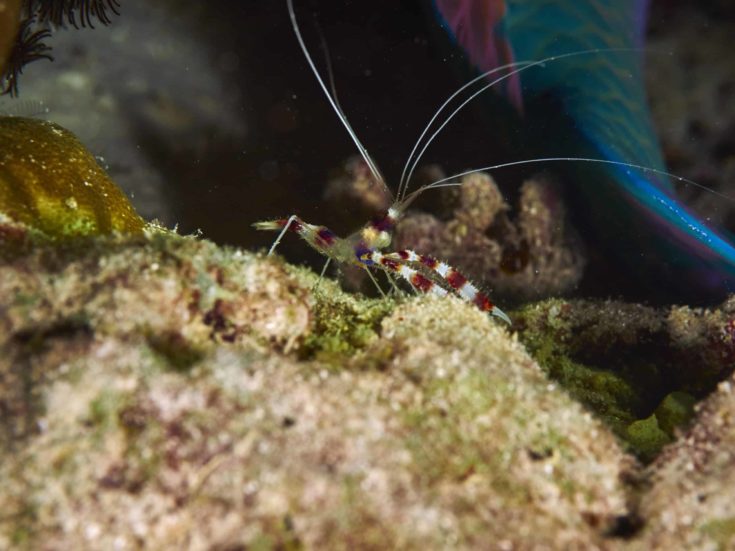
So, basically, you need to avoid keeping any fish species that are known to be predatory on invertebrates.
So, stick with fish that share similar water requirements to the species of crabs you’re keeping. Small, peaceful fish that gravitate toward the middle to upper areas of the water column are the best choice for a crab tank. Many shrimp species are fine with crabs but double-check to make sure that the crabs won’t try to eat the shrimp.
Can You Keep Crabs Together?
That depends on the species of crab that you want to keep. Some crabs are highly territorial, which can lead to aggression toward crabs of the same species, as well as other types.
You can mitigate that tendency somewhat by including lots of hiding places and caves in the tank. That way, each crab can claim a spot to call its own where it can keep clear of potential rivals.
Molting
Crabs molt regularly throughout their lives, basically because they outgrow their old shells and grow a larger one.
Once the crab’s shell has been shed, the creature is highly vulnerable to attack by other crabs and fish. You’ll notice that a crab that’s just molted will disappear for a few days while it waits for its new shell to harden. That’s why you must provide plenty of hiding spots for your crabs.
You might see what looks like a dead crab on the bottom of the tank. Don’t worry! That’s most likely just a molted crab shell. Leave the shell in the tank for a day or so, as sometimes the crabs will eat the old shell to get the calcium.
In Conclusion
Did you enjoy our guide to freshwater aquarium crabs? If you loved it, please share!
Most of the species we’ve featured here are relatively easy to care for and peaceful, so you can include them in a community setup. However, before you dash out to buy some of these beautiful, fascinating little crustaceans, you need to check if the species is fully or semi-aquatic. Semi-aquatic crabs need to be housed in a paludarium with areas of land, or they will drown.
If you have any questions about keeping pet crabs or setting up a paludarium, please ask in the comments box below!